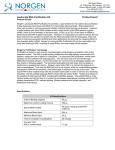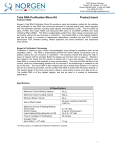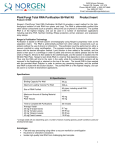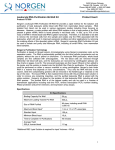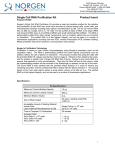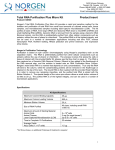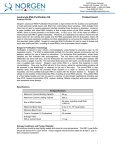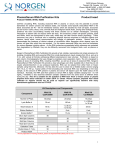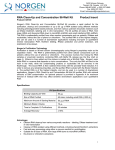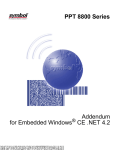Download Cytoplasmic & Nuclear RNA Purification Kit Product Insert
Transcript
3430 Schmon Parkway Thorold, ON, Canada L2V 4Y6 Phone: 866-667-4362 (905) 227-8848 Fax: (905) 227-1061 Email: [email protected] Cytoplasmic & Nuclear RNA Purification Kit Product Insert Product # 21000, 37400 Norgen’s Cytoplasmic & Nuclear RNA Purification Kit provides a rapid method for the isolation and purification of both cytoplasmic and nuclear RNA from cultured animal cells and small tissue samples. In certain circumstances it is desirable to be able to isolate fractionated RNA as opposed to total RNA. For example, it may be preferable to isolate only mature, cytoplasmic RNA for some studies on expression profiling. Alternatively it may be desirable to isolate nuclear RNA in order to investigate and study pre-processed (non-spliced) RNA. Furthermore, this kit can be used to isolate RNA for downstream applications where it is necessary to avoid DNA contamination, since the cytoplasmic fraction has been shown to be free of all traces of genomic DNA. Norgen’s Cytoplasmic & Nuclear RNA Purification Kit can be used to isolate all sizes of RNA from the cytoplasmic and nuclear RNA fractions, including all small RNA species. The kit is supplied with sufficient reagents to perform either 50 cytoplasmic RNA preparations or 25 cytoplasmic and 25 nuclear RNA preparations. Norgen’s Purification Technology Purification is based on spin column chromatography using Norgen’s proprietary resin as the separation matrix. The cytoplasmic RNA is preferentially purified from the nuclear RNA and other cellular components such as proteins, without the use of phenol or chloroform. The process involves first lysing the cells or tissue of interest with the provided Lysis Buffer J (please see the flow chart on page 4). The lysate is then separated through centrifugation, with the supernatant containing the cytoplasmic RNA and the pellet containing the nuclear RNA. Buffer SK and ethanol are then added to the desired fraction, and the solution is loaded onto a spin-column. Norgen’s resin binds RNA in a manner that depends on ionic concentrations. Thus only the RNA will bind to the column, while the contaminating proteins will be removed in the flowthrough or retained on the top of the resin. The bound RNA is then washed with the provided Wash Solution A in order to remove any remaining impurities, and the purified RNA is eluted with the Elution Buffer E. The purified RNA is of the highest integrity, and can be used in a number of downstream applications including real time PCR, reverse transcription PCR, Northern blotting, RNase protection and primer extension, and expression array assays. Specifications Kit Specifications Maximum Column Binding Capacity 50 g Maximum Column Loading Volume 650 L Size of RNA Purified All sizes, including small RNA (<200 nt) Maximum Amount of Starting Material: Animal Cells Animal Tissues 3 x 10 cells 15 mg Time to Complete 10 Purifications 45 minutes Average Yields* 6 HeLa Cells – cytoplasmic (1 x 10 cells) 6 HeLa Cells – nuclear (1 x 10 cells) 15 g 3.5 g 6 * average yields will vary depending upon a number of factors including species, growth conditions used and developmental stage. 1 Advantages Fast and easy processing using rapid spin-column format Isolate fractionated RNA from a variety of sources No phenol or chloroform extractions No genomic DNA contamination in the cytoplasmic fraction Isolate all sizes of RNA from each fraction, including all small RNA molecules (<200 nt) High quality RNA can be used in various downstream applications Kit Components Component Lysis Buffer J Buffer SK Wash Solution A Elution Buffer E Mini Spin Columns Collection Tubes Elution tubes (1.7 mL) Product Insert Product # 21000 (50 preps) 20 mL 40 mL 38 mL 6 mL 50 50 50 1 Product # 37400 (100 preps) 2 x 20 mL 2 x 40 mL 2 x 38 mL 2 x 6 mL 100 100 100 1 Storage Conditions and Product Stability All solutions should be kept tightly sealed and stored at room temperature. These reagents should remain stable for at least 1 year in their unopened containers. Precautions and Disclaimers This kit is designed for research purposes only. It is not intended for human or diagnostic use. Ensure that a suitable lab coat, disposable gloves and protective goggles are worn when working with chemicals. For more information, please consult the appropriate Material Safety Data Sheets (MSDSs). These are available as convenient PDF files online at www.norgenbiotek.com. Customer-Supplied Reagents and Equipment For All Protocols Benchtop microcentrifuge -mercaptoethanol 96 - 100% ethanol RNase-free microcentrifuge tubes For Animal Tissue Protocol Homogenizer (e.g. mortar and pestle, microtube pestle) 2 Working with RNA RNases are very stable and robust enzymes that degrade RNA. Autoclaving solutions and glassware is not always sufficient to actively remove these enzymes. The first step when preparing to work with RNA is to create an RNase-free environment. The following precautions are recommended as your best defense against these enzymes. The RNA area should be located away from microbiological work stations Clean, disposable gloves should be worn at all times when handling reagents, samples, pipettes, disposable tubes, etc. It is recommended that gloves are changed frequently to avoid contamination There should be designated solutions, tips, tubes, lab coats, pipettes, etc. for RNA only All RNA solutions should be prepared using at least 0.05% DEPC-treated autoclaved water or molecular biology grade nuclease-free water Clean all surfaces with commercially available RNase decontamination solutions When working with purified RNA samples, ensure that they remain on ice during downstream applications 3 Flow Chart Procedure for Purifying Cytoplasmic and Nuclear RNA Molecules Lyse cells using Lysis Buffer J (monolayer, cell suspension, lifted cells or tissues) Centrifuge to separate cell fractions Supernatant (Cytoplasmic Fraction) Pellet (Nuclear Fraction) Add Buffer SK Add Buffer SK Add Ethanol Add Ethanol Bind RNA SPIN Bind RNA SPIN Wash RNA SPIN Wash RNA SPIN Elute RNA SPIN Cytoplasmic RNA Elute RNA SPIN Nuclear RNA 4 Procedures All centrifugation steps are carried out in a benchtop microcentrifuge. Various speeds are required for different steps, so please check your microcentrifuge specifications to ensure that it is capable of the proper speeds. All centrifugation steps are performed at room temperature. The correct rpm can be calculated using the formula: RPM = RCF (1.118 x 10-5) (r) where RCF = required gravitational acceleration (relative centrifugal force in units of g); r = radius of the rotor in cm; and RPM = the number of revolutions per minute required to achieve the necessary g-force. A. Protocols for Cytoplasmic and Nuclear RNA Purification from Cultured Animal Cells All centrifugation steps are carried out in a benchtop microcentrifuge at 14,000 x g (~14,000 RPM) except where noted. All centrifugation steps are performed at room temperature. A variable speed centrifuge should be used for maximum kit performance. If a variable speed centrifuge is not available a fixed speed centrifuge can be used, however reduced yields may be observed. Notes Prior to Use Ensure that all solutions except Lysis Buffer J are at room temperature prior to use. Prepare an appropriate amount of Lysis Buffer J by adding 10 L of -mercaptoethanol (provided by the user) to each 1 mL of Lysis Buffer J required. Place the solution on ice or at 4°C prior to use. -mercaptoethanol is toxic and should be dispensed in a fume hood. Prepare an appropriate amount of Buffer SK by adding 10 L of -mercaptoethanol (provided by the user) to each 1 mL of Buffer SK required. -mercaptoethanol is toxic and should be dispensed in a fume hood. Prepare a working concentration of the Wash Solution A by adding 90 mL of 96 - 100% ethanol (provided by the user) to each supplied bottle containing the concentrated Wash Solution A. This will give a final volume of 128 mL. The labels on the bottles have a box that may be checked to indicate that the ethanol has been added. 6 The maximum recommended input of cells is 3 x 10 . A hemocytometer can be used in conjunction with a microscope to count the number of cells. As a general guideline, a 6 confluent 3.5 cm plate of HeLa cells will contain 10 cells. Fresh cultured animal cells are the recommended input for this procedure. Cell pellets can be stored at -70°C for later use or used directly in the procedure. Determine the number of cells present before freezing. Frozen pellets should be stored for no longer than 2 weeks to ensure that the integrity of the RNA is not compromised. Frozen cell pellets should not be thawed prior to beginning the protocol. Add the Lysis Buffer J directly to the frozen cell pellet (Step A(ii) 1c). It is important to work quickly during this procedure. 5 (i) Cells Growing in a Monolayer 1. Cell Fraction Preparation a. Aspirate media and wash cell monolayer with an appropriate amount of PBS. Aspirate PBS. b. Add 200 L of ice-cold Lysis Buffer J directly to culture plate. c. Lyse cells by gently tapping culture dish and swirling buffer around plate surface for five minutes, while keeping the cell culture plate on ice. d. Using a pipette, transfer lysate to an RNase-free microcentrifuge tube (not provided). Spin lysate for 3 minutes at maximum speed in a benchtop centrifuge. Transfer the supernatant containing cytoplasmic RNA to another RNase-free tube (not provided). If nuclear RNA extraction is desired, retain the pellet containing the nuclear RNA. Continue immediately to Step 2. Note: Depending on the amount of cells used, the nuclear RNA fraction (pellet) may or may not be visible. A few L of Lysis Buffer J may be left behind with the pellet in order to ensure that the pellet is not dislodged. 2A. Binding Cytoplasmic RNA to Column a. Add 200 L of Buffer SK to the supernatant (cytoplasmic RNA fraction) from step 1d. Mix by vortexing for 10 seconds. b. Add 200 L of 96 - 100% ethanol (provided by the user) to the mixture. Mix by vortexing for 10 seconds. d. Apply the mixture onto a spin column that has been assembled with a collection tube, and centrifuge for 1 minute at ≥ 3,500 x g (~6,000 RPM). e. Discard the flowthrough. Reassemble the spin column with its collection tube. 2B. Binding Nuclear RNA to Column a. Add 400 L of Buffer SK to the pellet (nuclear RNA fraction) from step 1d. Mix by vortexing for 10 seconds. b. Add 200 L of 96 - 100% ethanol (provided by the user) to the mixture. Mix by vortexing for 10 seconds. 6 Note: For input amounts greater than 10 cells, it is recommended that the lysate is passed through a 25 gauge needle attached to a syringe 5-10 times at this point, in order to shear the genomic DNA prior to loading onto the column. d. Apply the mixture onto a second spin column that has been assembled with a collection tube, and centrifuge for 1 minute at ≥ 3,500 x g (~6,000 RPM). e. Discard the flowthrough. Reassemble the spin column with its collection tube. Optional Step: Norgen’s Cytoplasmic & Nuclear RNA Purification Kit isolates nuclear RNA with minimal amounts of genomic DNA contamination. However, an optional On-Column DNA Removal Protocol is provided in Appendix A for maximum removal of residual DNA that may affect sensitive downstream applications. This step should be performed at this point in the protocol. It is recommended that Norgen’s RNase-Free DNase I Kit (Product # 25710) be used for this step. The DNA Removal Protocol is not required for downstream applications of the cytoplasmic fraction. 6 3. Column Wash a. Apply 400 μL of Wash Solution A to the column and centrifuge for 1 minute. Discard the flowthrough. Note: Ensure the entire Wash Solution A has passed through into the collection tube by inspecting the column. If the entire wash volume has not passed, spin for an additional minute. b. Repeat step 3a to wash column a second time. c. Wash column a third time by adding another 400 L of Wash Solution A and centrifuging for 1 minute. d. Discard the flowthrough and reassemble the spin column with its collection tube. e. Spin the column for 2 minutes in order to thoroughly dry the resin. Discard the collection tube. 4. RNA Elution a. Place the column into a fresh 1.7 mL Elution tube provided with the kit. b. Add 50 L of Elution Buffer E to the column. c. Centrifuge for 2 minutes at 200 x g (~2,000 RPM), followed by 1 minute at 14,000 x g (~14,000 RPM) Note the volume eluted from the column. If the entire 50 L has not been eluted, spin the column at 14,000 x g (~14,000 RPM) for 1 additional minute. Note: For maximum RNA recovery, it is recommended that a second elution be performed into a separate microcentrifuge tube (Repeat Steps 4b and 4c). 5. Storage of RNA The purified RNA sample may be stored at –20°C for a few days. It is recommended that samples be placed at –70°C for long term storage. (ii) Cells Growing in Suspension and Lifted Cells 1. Cell Fractions Preparation a. Transfer cell suspension to an RNase-free tube (not provided) and centrifuge at no more than 200 x g (~2,000 RPM) for 10 minutes to pellet cells. b. Carefully decant the supernatant. A few L of media may be left behind with the pellet in order to ensure that the pellet is not dislodged. c. Add 200 L of ice-cold Lysis Buffer J to the pellet. Lyse cells by vortexing for 15 seconds. Ensure that the entire pellet is completely dissolved before proceeding to the next step. d. Spin lysate for 3 minutes at maximum speed in a benchtop centrifuge. Transfer the supernatant containing cytoplasmic RNA to an RNase-free tube (not provided). If nuclear RNA extraction is desired, retain the pellet containing the nuclear RNA. Continue immediately to Step 2. 7 Note: Depending on the amount of cells used, the nuclear RNA fraction (pellet) may or may not be visible. A few L of Lysis Buffer J may be left behind with the pellet in order to ensure that the pellet is not dislodged. 2A. Binding Cytoplasmic RNA to Column a. Add 200 L of Buffer SK to the supernatant (cytoplasmic RNA fraction) from step 1d. Mix by vortexing for 10 seconds. b. Add 200 L of 96 - 100% ethanol (provided by the user) to the mixture. Mix by vortexing for 10 seconds. c. Apply the mixture onto a spin column that has been assembled with a collection tube, and centrifuge for 1 minute at ≥ 3,500 x g (~6,000 RPM). d. Discard the flowthrough. Reassemble the spin column with its collection tube. 2B. Binding Nuclear RNA to Column a. Add 400 L of Buffer SK to the pellet (nuclear RNA fraction) from step 1d. Mix by vortexing for 10 seconds. b. Add 200 L of 96 - 100% ethanol (provided by the user) to the mixture. Mix by vortexing for 10 seconds. 6 Note: For input amounts greater than 10 cells, it is recommended that the lysate is passed through a 25 gauge needle attached to a syringe 5-10 times at this point, in order to shear the genomic DNA prior to loading onto the column. c. Apply the mixture onto a spin column that has been assembled with a collection tube, and centrifuge for 1 minute at ≥ 3,500 x g (~6,000 RPM). d. Discard the flowthrough. Reassemble the spin column with its collection tube. Optional Step: Norgen’s Cytoplasmic & Nuclear RNA Purification Kit isolates nuclear RNA with minimal amounts of genomic DNA contamination. However, an optional On-Column DNA Removal Protocol is provided in Appendix A for maximum removal of residual DNA that may affect sensitive downstream applications. This step should be performed at this point in the protocol. It is recommended that Norgen’s RNase-Free DNase I Kit (Product # 25710) be used for this step. The DNA Removal Protocol is not required for downstream applications of the cytoplasmic fraction. 3. Column Wash a. Apply 400 μL of Wash Solution A to the column and centrifuge for 1 minute. Discard the flowthrough. Note: Ensure the entire Wash Solution A has passed through into the collection tube by inspecting the column. If the entire wash volume has not passed, spin for an additional minute. b. Repeat step 3a to wash column a second time. c. Wash column a third time by adding another 400 L of Wash Solution A and centrifuging for 1 minute. d. Discard the flowthrough and reassemble the spin column with its collection tube. e. Spin the column for 2 minutes in order to thoroughly dry the resin. Discard the collection tube. 8 4. RNA Elution a. Place the column into a fresh 1.7 mL Elution tube provided with the kit. b. Add 50 L of Elution Buffer E to the column. c. Centrifuge for 2 minutes at 200 x g (~2,000 RPM), followed by 1 minute at 14,000 x g (~14,000 RPM) Note the volume eluted from the column. If the entire 50 L has not been eluted, spin the column at 14,000 x g (~14,000 RPM) for 1 additional minute. Note: For maximum RNA recovery, it is recommended that a second elution be performed into a separate microcentrifuge tube (Repeat Steps 4b and 4c). 5. Storage of RNA The purified RNA sample may be stored at –20°C for a few days. It is recommended that samples be placed at –70°C for long term storage. B. Protocol for Cytoplasmic and Nuclear RNA Purification from Animal Tissues All centrifugation steps are carried out in a benchtop microcentrifuge at 14,000 x g (~14,000 RPM) except where noted. All centrifugation steps are performed at room temperature. A variable speed centrifuge should be used for maximum kit performance. If a variable speed centrifuge is not available a fixed speed centrifuge can be used, however reduced yields may be observed. Notes Prior to Use Ensure that all solutions except Lysis Buffer J are at room temperature prior to use. Prepare an appropriate amount of Lysis Buffer J by adding 10 L of -mercaptoethanol (provided by the user) to each 1 mL of Lysis Buffer J required. Place the solution on ice or at 4°C prior to use. -mercaptoethanol is toxic and should be dispensed in a fume hood. Prepare an appropriate amount of Buffer SK by adding 10 L of mercaptoethanol (provided by the user) to each 1 mL of Buffer SK required. mercaptoethanol is toxic and should be dispensed in a fume hood. Prepare a working concentration of the Wash Solution A by adding 90 mL of 96 - 100% ethanol (provided by the user) to the supplied bottle containing the concentrated Wash Solution A. This will give a final volume of 128 mL. The label on the bottle has a box that may be checked to indicate that the ethanol has been added. RNA in animal tissues is not protected after harvesting until it is disrupted and homogenized. Thus it is important that the procedure is carried out as quickly as possible, particularly the Cell Fraction Preparation step. Fresh tissues are highly recommended for this procedure. Frozen tissues may be used for this procedure. Tissues should be flash-frozen in liquid nitrogen and transferred immediately to a -70°C freezer for long-term storage. Tissues may be stored at -70°C for several months. When isolating RNA from frozen tissues ensure that the tissue does not thaw during weighing or prior to grinding with the mortar and pestle. It is recommended that no more than 15 mg of tissue be used, in order to prevent clogging of the column. 9 1. Cell Fraction Preparation a. Excise the tissue sample from the animal. b. Determine the amount of tissue by weighing. It is recommended that no more than 15 mg of tissue be used for the protocol. c. Transfer the tissue into a mortar that contains an appropriate amount of liquid nitrogen to cover the sample. Grind the tissue thoroughly using a pestle. d. Allow the liquid nitrogen to evaporate, without allowing the tissue to thaw. e. Add 200 L of Lysis Buffer J to the tissue sample and continue the homogenization until the tissue dissolves. f. Using a pipette, transfer lysate to an RNase-free microcentrifuge tube (not provided). Spin lysate for 3 minutes at maximum speed in a benchtop centrifuge. Transfer the supernatant containing cytoplasmic RNA to another RNase-free tube (not provided). If nuclear RNA extraction is desired, retain the pellet containing the nuclear RNA. Continue immediately to Step 2. Note: Depending on the type of tissue used and the extent of homogenization, significant cytoplasmic RNA contamination in the nuclear RNA fraction may occur. 2A. Binding Cytoplasmic RNA to Column a. Add 200 L of Buffer SK to the supernatant (cytoplasmic RNA fraction) from step 1d. Mix by vortexing for 10 seconds. b. Add 200 L of 96 - 100% ethanol (provided by the user) to the mixture. Mix by vortexing for 10 seconds. c. Apply the mixture onto a spin column that has been assembled with a collection tube, and centrifuge for 1 minute at ≥ 3,500 x g (~6,000 RPM).. d. Discard the flowthrough. Reassemble the spin column with its collection tube. 2B. Binding Nuclear RNA to Column a. Add 400 L of Buffer SK to the pellet (nuclear RNA fraction) from step 1d. Mix by vortexing for 10 seconds. b. Add 200 L of 96 - 100% ethanol (provided by the user) to the mixture. Mix by vortexing for 10 seconds. Note: For input amounts greater than 10 mg, it is recommended that the lysate is passed through a 25 gauge needle attached to a syringe 5-10 times at this point, in order to shear the genomic DNA prior to loading onto the column. c. Apply the mixture onto a spin column that has been assembled with a collection tube, and centrifuge for 1 minute at ≥ 3,500 x g (~6,000 RPM).. d. Discard the flowthrough. Reassemble the spin column with its collection tube. 10 Optional Step: Norgen’s Cytoplasmic & Nuclear RNA Purification Kit isolates nuclear RNA with minimal amounts of genomic DNA contamination. However, an optional On-Column DNA Removal Protocol is provided in Appendix A for maximum removal of residual DNA that may affect sensitive downstream applications. This step should be performed at this point in the protocol. It is recommended that Norgen’s RNase-Free DNase I Kit (Product # 25710) be used for this step. The DNA Removal Protocol is not required for downstream applications of the cytoplasmic fraction. 3. Column Wash a. Apply 400 μL of Wash Solution A to the column and centrifuge for 1 minute. Discard the flowthrough Note: Ensure the entire Wash Solution A has passed through into the collection tube by inspecting the column. If the entire wash volume has not passed, spin for an additional minute. b. Repeat step 3a to wash column a second time. c. Wash column a third time by adding another 400 L of Wash Solution A and centrifuging for 1 minute. d. Discard the flowthrough and reassemble the spin column with its collection tube. e. Spin the column for 2 minutes in order to thoroughly dry the resin. Discard the collection tube. 4. RNA Elution a. Place the column into a fresh 1.7 mL Elution tube provided with the kit. b. Add 50 L of Elution Buffer E to the column. c. Centrifuge for 2 minutes at 200 x g (~2,000 RPM), followed by 1 minute at 14,000 x g (~14,000 RPM) Note the volume eluted from the column. If the entire 50 L has not been eluted, spin the column at 14,000 x g (~14,000 RPM) for 1 additional minute. Note: For maximum RNA recovery, it is recommended that a second elution be performed into a separate microcentrifuge tube (Repeat Steps 4b and 4c). 5. Storage of RNA The purified RNA sample may be stored at –20°C for a few days. It is recommended that samples be placed at –70°C for long term storage. 11 Appendix A Protocol for Optional On-Column DNA Removal Norgen’s Cytoplasmic & Nuclear RNA Purification Kit isolates nuclear RNA with minimal amounts of genomic DNA contamination. However, an optional protocol is provided below for maximum removal of residual DNA that may affect sensitive downstream applications. It is recommended that Norgen’s RNase-Free DNase I Kit (Product # 25710) be used for this step. 1. For every on-column reaction to be performed, prepare a mix of 15 L of DNase I and 100 µL of Enzyme Incubation Buffer using Norgen’s RNase-Free DNase I Kit (Product # 25710). Mix gently by inverting the tube a few times. DO NOT VORTEX. Note: If using an alternative DNase I, prepare a working stock of 0.25 Kunitz unit/L RNase-free DNase I solution according to the manufacturer’s instructions. A 100 L aliquot is required for each column to be treated. 2. Perform the appropriate Nuclear RNA Isolation protocol for your starting material up to and including “Binding to Column” (Step 2B of all protocols). 3. Apply 400 L of Wash Solution A to the column and centrifuge for 2 minutes. Discard the flowthrough. Reassemble the spin column with its collection tube. 4. Apply 100 L of the RNase-free DNase I solution prepared in Step 1 to the column and centrifuge at 14, 000 x g (~14 000 RPM) for 1 minute. Note: Ensure that the entire DNase I solution passes through the column. If needed, spin at 14, 000 x g (~14 000 RPM) for an additional minute. 5. After the centrifugation in Step 4, pipette the flowthrough that is present in the collection tube back onto the top of the column. Note: Ensure Step 5 is performed in order to ensure maximum DNase activity and to obtain maximum yields of RNA, in particular for small RNA species. o 6. Incubate the column assembly at 25 - 30 C for 15 minutes. 7. Without further centrifugation, proceed directly to the second wash step in the “Column Wash” (Step 3b of all protocols). 12 Troubleshooting Guide Problem Poor RNA Recovery Clogged Column Possible Cause Solution and Explanation Insufficient solubilization of cells or tissue Ensure that the appropriate amount of Lysis Buffer J was used for the amount of cells or tissue. Column has become clogged Do not exceed the recommended amounts of starting materials. The amount of starting material may need to be decreased if the column shows clogging below the recommended levels. See also “Clogged Column” below. An alternative elution solution was used It is recommended that the Elution Buffer E supplied with this kit be used for maximum RNA recovery. Ethanol was not added to the lysate Ensure that the appropriate amount of ethanol is added to the lysate before binding to the column. Ethanol was not added to the Wash Solution A Ensure that 90 mL of 96 - 100% ethanol is added to the supplied Wash Solution A prior to use. Cell Culture: Cell monolayer was not washed with PBS Ensure that the cell monolayer is washed with the appropriate amount of PBS in order to remove residual media from cells. Insufficient solubilization of cells or tissues Ensure that the appropriate amount of Lysis Buffer J was used for the amount of cells or tissue. Maximum number of cells or amount of tissue exceeds kit specifications Refer to specifications to determine if amount of starting material falls within kit specifications High amounts of genomic DNA present in sample The nuclear lysate fraction may be passed through a 25 gauge needle attached to a syringe 5-10 times in order to shear the genomic DNA prior to loading onto the column. Centrifuge temperature too low Ensure that the centrifuge remains at room temperature throughout the procedure. Temperatures below 15°C may cause precipitates to form that can cause the columns to clog. 13 Problem RNA is Degraded RNA does not perform well in downstream applications Genomic DNA contamination in cytoplasmic fraction Possible Cause Solution and Explanation RNase contamination RNases may be introduced during the use of the kit. Ensure proper procedures are followed when working with RNA. Please refer to “Working with RNA” at the beginning of this user guide. Procedure not performed quickly enough In order to maintain the integrity of the RNA, it is important that the procedure be performed quickly. This is especially important for the Cell Lysate Preparation Step in the Animal Tissue protocol, since the RNA in animal tissues is not protected after harvesting until it is disrupted and homogenized. Improper storage of the purified RNA For short term storage RNA samples may be stored at –20°C for a few days. It is recommended that samples be stored at –70°C for longer term storage. Frozen tissues or cell pellets were allowed to thaw prior to RNA isolation Do not allow frozen tissues to thaw prior to grinding with the mortar and pestle in order to ensure that the integrity of the RNA is not compromised. Tissue samples were frozen improperly Samples should be flash-frozen in liquid nitrogen and transferred immediately to a -70°C freezer for long-term storage. RNA was not washed three times with the provided Wash Solution A Traces of salt from the binding step may remain in the sample if the column is not washed three times with Wash Solution A. Salt may interfere with downstream applications, and thus must be washed from the column. Ethanol carryover Ensure that the dry spin under the Column Wash procedure is performed, in order to remove traces of ethanol prior to elution. Ethanol is known to interfere with many downstream applications. Traces of nuclear pellet remained in cytoplasmic fraction Ensure that a solid pellet is formed at the end of the Cell Fraction Preparation step, and that none of the pellet is removed when the supernatant is transferred to another tube. 14 Related Products RNase-Free DNase I Kit Total RNA Purification Kit Leukocyte RNA Purification Kit microRNA Purification Kit 100b RNA Ladder 1kb RNA Ladder Product # 25710 17200 21200 21300 15002 15003 Technical Support Contact our Technical Support Team between the hours of 8:30 and 5:30 (Eastern Standard Time) at (905) 227-8848 or Toll Free at 1-866-667-4362. Technical support can also be obtained from our website (www.norgenbiotek.com) or through email at [email protected]. 3430 Schmon Parkway, Thorold, ON Canada L2V 4Y6 Phone: (905) 227-8848 Fax: (905) 227-1061 Toll Free in North America: 1-866-667-4362 © 2014 Norgen Biotek Corp. PI21000-19-M14 15















